Lucia Lee
Last update: 23/10/2025
Every click, scroll, and second on your website matters - because that’s where potential customers decide whether to stay or leave. Understanding the story behind customer behavior is key to turning interactions into sales opportunities, yet many businesses still struggle with it. AI for conversion rate optimization has emerged as a game-changer, unlocking smarter insights, personalized experiences, and data-driven decisions that traditional methods simply can’t match. Keep reading to discover how AI is transforming this process - and how your business can harness it to boost conversion rates.
Conversion rate optimization (CRO) is the process of improving a website’s ability to turn visitors into customers or leads - whether that means completing a purchase, filling out a form, or signing up for a service. In essence, it’s about understanding what motivates, distracts, or convinces users and then refining the digital experience to encourage desired actions. Traditional CRO often relies on A/B testing, manual analysis, and gradual changes to content, layout, or messaging to boost performance over time.
With the rise of artificial intelligence (AI), CRO has evolved far beyond manual testing and guesswork. AI for conversion rate optimization leverages machine learning algorithms to analyze vast amounts of user data - from click patterns and browsing behavior to engagement time and purchase history. It identifies trends, predicts user intent, and suggests real-time adjustments that maximize conversions. Unlike traditional methods, AI continuously learns from every interaction, helping CRO effectiveness increase over time.
There are many ways your business can use AI for conversion rate optimization. Instead of relying on intuition or slow manual testing, AI tools now provide instant insights, automate improvements, and deliver hyper-personalized experiences that drive measurable growth. Let’s explore the key applications of AI in CRO:
Predictive analytics for conversion optimization
One of the most powerful ways AI is changing CRO is through predictive analytics for conversion optimization. By using machine learning for user behavior prediction, AI systems analyze massive amounts of data - from click patterns and dwell time to cart abandonment and purchase frequency. This enables you to forecast what users are likely to do next, such as whether they’ll make a purchase or leave the site, so you can make data-driven decisions that boost conversion rates.
Smart recommendations to boost sales
Personalized product recommendations have become central to ecommerce success. AI systems deliver uniquely relevant recommendations to the right customer at the right moment by analyzing browsing data, purchase history, and contextual cues. Unlike static recommendation systems, AI continuously refines its accuracy using machine learning user behavior analysis and predictive analytics, ensuring recommendations evolve along with customer’s needs and preferences over time.
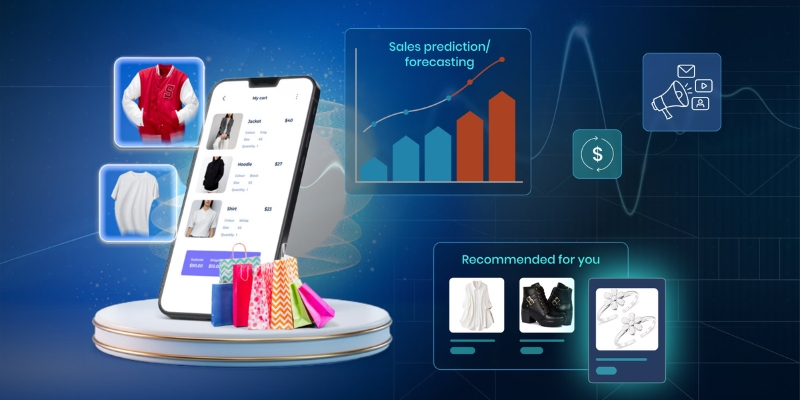
Smart recommendations to boost sales
Adaptive content personalization with AI
Dynamic content that resonates with customers on a personal level is more likely to convert. Thankfully, you can create such adaptive personalized content at scale by leveraging AI for conversion rate optimization. AI tools track browsing patterns, engagement levels, and prior purchases to deliver the most relevant content for each visitor.
Imagine a shopper exploring your site for tech accessories. AI can instantly display curated product collections, tailor messaging to their interests, and even adjust the visuals or tone of the landing page - all in real time. This seamless behavioral targeting ensures every user gets a version of your site that aligns with their current intent - not a one-size-fits-all experience.
A/B testing automation and real-time optimization
Traditional A/B testing can be slow and limited, but AI has turned it into an automated, always-learning process. A/B testing automation powered by machine learning enables systems to run multiple tests simultaneously, detect patterns faster, and dynamically allocate traffic to the best-performing versions.
This adaptive testing model helps businesses avoid wasting time and traffic on underperforming designs. It accelerates funnels optimization, reduces manual labor, and ensures your website is always showing what converts best.
Customer segmentation and predictive personalization
Gone are the days of static audience segmentation. With AI for conversion rate optimization, customer grouping becomes fluid and dynamic. Customer segmentation is now based on live signals - such as engagement levels, device type, and purchase behavior - allowing marketers to reach users with hyper-relevant content at precisely the right time.
Chatbots and conversational optimization
AI-powered chatbots are redefining real-time customer engagement. These intelligent systems provide personalized guidance, answer objections, and recommend products - all while collecting valuable data for user behavior analysis.
As a crucial part of AI for conversion rate optimization strategies, chatbots act as conversion catalysts, reducing drop-offs and helping users make decisions faster. They can trigger dynamic content like promotional pop-ups or personalized offers based on live conversation cues, leading to smoother, more human-like experiences that boost overall conversions.
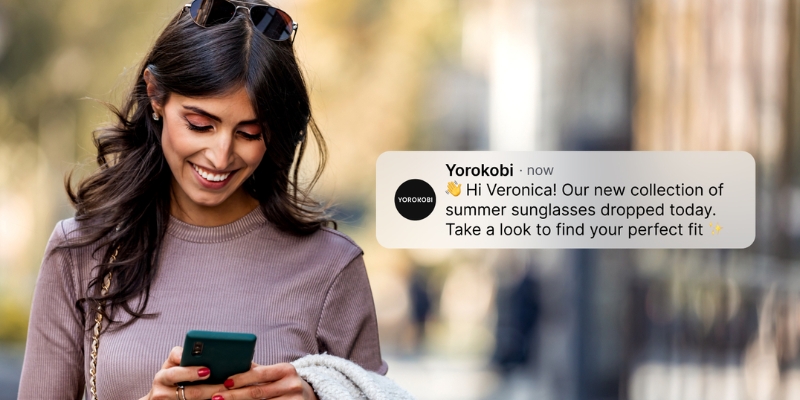
Chatbots and conversational optimization
Also read: AI in Customer Services: The Ultimate Guide
Adopting AI for conversion rate optimization is like giving your marketing strategy a supercharged engine - one that runs faster, learns smarter, and works around the clock. Here’s how your business can benefit from using AI to optimize conversions and drive measurable growth.
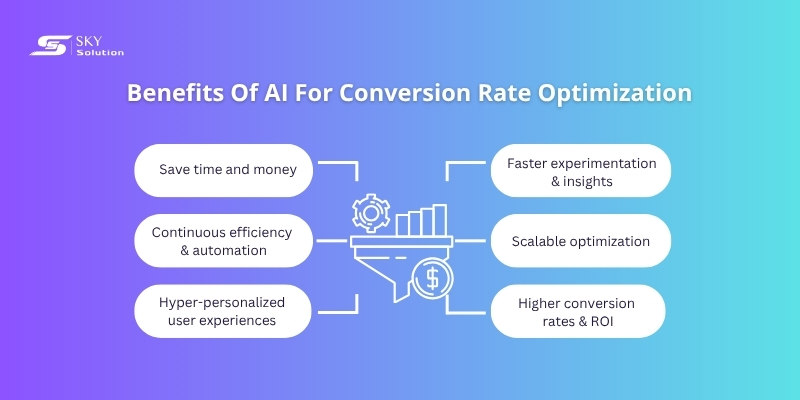
Benefits of using AI for conversion rate optimization
Save time and money
Traditional CRO can be resource-heavy, often requiring full-time specialists or costly testing tools. AI changes that. By automating data collection, analysis, and testing, AI removes the need for large optimization teams - saving both time and budget.
Continuous efficiency and automation
AI works tirelessly behind the scenes to keep your optimization process running 24/7. It automatically tracks performance, tests variations, and identifies improvement areas - all without manual input. This means your website is constantly learning and evolving, and your teams can focus on creative strategy, innovation, and customer experience rather than repetitive tasks.
Hyper-personalized user experiences
AI-powered personalization takes user experience to a new level. Instead of offering one-size-fits-all content, AI adapts in real time to each visitor’s behavior, preferences, and intent. These personal touches make visitors feel understood, leading to stronger engagement and higher conversion rates.
Faster experimentation and insights
In traditional CRO, testing one idea at a time can slow progress. AI enables parallel testing - running hundreds of experiments simultaneously while learning from every interaction. This speed helps your business maintain momentum, sharpen strategies, and stay ahead in fast-moving markets.
Scalable optimization for any business size
AI makes enterprise-level CRO accessible to everyone. Whether you’re a growing startup or a global brand, AI tools can handle large-scale data, automate experiments, and deliver insights that scale with your business.
As traffic grows, AI systems adapt - managing complexity effortlessly without needing additional manpower. This ensures continuous optimization as your audience expands.
Higher conversion rates and ROI
Ultimately, all these benefits of AI for conversion rate optimization lead to one outcome - better conversions. AI fine-tunes every element of the funnel, personalizes every step of the customer journey, and ensures that every visitor gets the most relevant experience possible.
AI can supercharge your conversion strategy - but only when applied thoughtfully. Many businesses jump into AI too quickly or overlook critical foundations like data quality and human oversight. To truly maximize AI’s potential, it’s essential to combine automation with strategy, structure, and a continuous improvement mindset.
Here are the best practices to guide your AI for conversion rate optimization journey.
Start small and scale strategically
AI offers powerful capabilities, but trying to overhaul everything at once can backfire. Many companies make the mistake of adopting too many tools too fast, leading to confusion, wasted resources, and inconsistent results.
Instead, begin with one area - such as optimizing landing pages or product recommendations - and expand as your team becomes more comfortable with AI-driven processes. A gradual rollout of AI for conversion rate optimization allows you to test, refine, and ensure that each tool delivers measurable impact before moving on to the next phase.
If you’re new to AI, look for platforms that provide guided onboarding or built-in assistance to ease the learning curve.
Feed AI with high-quality, clean data
AI is only as smart as the data it receives. Poor, inconsistent, or outdated data can lead to misleading insights and flawed recommendations. Before deploying AI tools, make sure your analytics, tracking codes, and data sources are clean, structured, and aligned with your CRO goals. Regularly audit your data for accuracy, completeness, and relevance.
If your internal datasets are limited, consider partnering with vendors or agencies that have robust first-party data to enhance reliability and improve predictive performance.
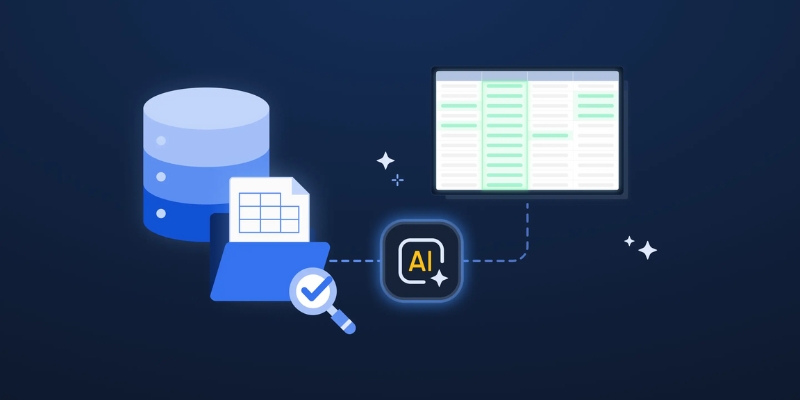
Feed AI with high-quality, clean data
Keep human expertise in the loop
While AI for conversion rate optimization automates analysis and testing, human intuition still plays a vital role in interpreting context and making strategic decisions.
Your marketing and CRO specialists understand brand tone, user psychology, and market nuances - areas where AI still has limits. Maintain human oversight to validate AI insights, fine-tune campaigns, and ensure ethical, user-friendly experiences.
Think of AI as an intelligent assistant that supports decision-making, not a replacement for human judgment.
Foster a data-driven optimization culture
AI thrives in organizations that value continuous learning and evidence-based decision-making. Encourage teams to regularly review performance metrics, question assumptions, and embrace testing as an ongoing process - not a one-time project.
Building a data-driven culture helps ensure that every decision, from design tweaks to campaign adjustments, is supported by actionable insights. Over time, this mindset makes optimization a natural part of your workflow rather than an isolated task.
Also read: Agentic AI in Ecommerce: Entering A New Era of Online Retail
Continuously test, validate, and iterate
CRO success depends on continuous experimentation. Use AI-powered A/B or multivariate testing to experiment with page layouts, copy, CTAs, and offers. These tools can automatically detect winning variants and adapt experiences in real time.
AI also enables “what-if” simulations - allowing you to model user reactions before implementing major changes. Regular iteration based on test results ensures that your optimization strategy evolves with shifting user behavior, keeping your site fresh and conversion-focused.
Monitor performance and AI decisions in real time
Transparency is key when using AI for conversion rate optimization. Set up dashboards to monitor real-time results, detect anomalies, and understand how AI systems are making decisions.
This allows your team to stay proactive - spotting issues before they impact users and fine-tuning models as needed. The goal is to maintain a balance between automation and accountability, ensuring that AI continues to deliver measurable, sustainable value.
While AI has transformed how businesses optimize conversions, it isn’t without its challenges. From data dependency to creative limitations, several factors can affect the effectiveness and reliability of AI for conversion rate optimization.
Complexity of consumer behavior
Consumer behavior is influenced by a web of psychological, cultural, social, and economic factors. These variables constantly shift, making it challenging for businesses to truly understand what drives conversions.
Although AI can process vast datasets and uncover hidden trends much faster than humans, it still struggles to capture deeper emotional and contextual nuances behind user actions. For example, an AI tool may recognize that visitors abandon a page after a certain point - but it might not fully grasp whether the cause is frustration, confusion, or lack of trust.
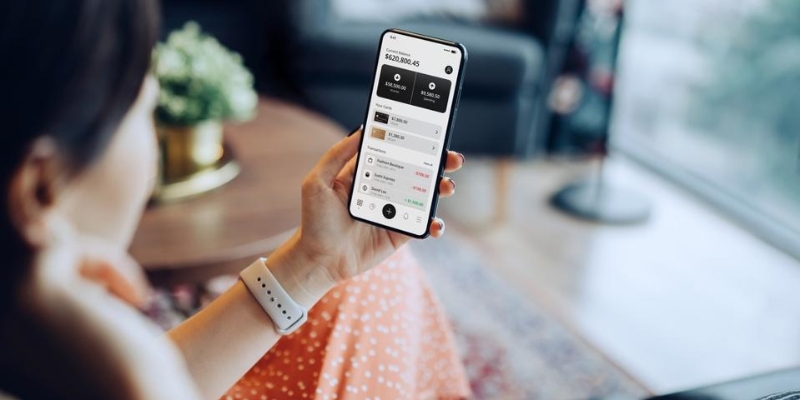
Complexity of consumer behavior
Data dependency and quality issues
AI models are only as strong as the data they’re trained on. Inaccurate, incomplete, or biased data can lead to unreliable recommendations and poor optimization outcomes.
For new websites or pages with low traffic, AI tools may also struggle to make accurate predictions due to insufficient data. This can result in inconclusive insights or misleading conclusions that harm performance instead of improving it.
Technical limitations and integration challenges
Deploying AI tools for CRO isn’t always plug-and-play. Many advanced platforms require complex integration with existing tech stacks such as analytics systems, content management tools, or customer databases.
Without strong technical support, implementation can become time-consuming or error-prone. Additionally, real-time website monitoring and maintenance require systems that can handle large-scale automation without disrupting site performance.
AI can help by detecting issues early, prioritizing fixes based on potential conversion impact, and automating certain maintenance tasks - but human oversight remains essential to ensure reliability and smooth functionality.
Lack of human creativity and context
While AI excels at data analysis, it lacks the creative judgment and emotional sensitivity that drive authentic marketing. AI-generated recommendations can sometimes feel repetitive or overly mechanical, missing the storytelling or brand voice that builds trust and long-term engagement.
In some cases, AI might prioritize short-term performance - such as slightly higher click-through rates - over maintaining consistent branding or emotional appeal. That’s why human creativity and strategic thinking are irreplaceable in guiding AI-driven decisions. AI should enhance, not dictate, your marketing vision.
Privacy and ethical concerns
AI for conversion rate optimization relies on tracking user behaviors, preferences, and interactions - often in real time. While this data enables powerful personalization, it also raises privacy and compliance issues. Businesses must handle personal data responsibly and ensure full compliance with data protection laws like GDPR and CCPA. Transparency, consent, and secure data handling should be built into every AI-driven process to maintain user trust and avoid legal risks.
Resource and budget constraints
AI for conversion rate optimization requires ongoing analysis, testing, and refinement - all of which can be resource-intensive. Smaller businesses may struggle to afford or maintain sophisticated AI systems.
However, AI can also be a solution when used wisely. It can automate repetitive analytical tasks, reduce manual workload, and allow teams to focus on creative strategy. The key is to scale AI adoption gradually, starting with high-impact areas and expanding as resources and expertise grow.
AI for conversion rate optimization isn’t just about smarter data - it’s about creating experiences that truly connect with your customers. By combining automation, personalization, and predictive insights, businesses can turn every interaction into an opportunity to convert and grow.
If you’re ready to boost your ecommerce performance with AI-driven insights and automation, Sky Solution’s AI solutions are here to help. From behavior analytics to intelligent testing, we’ll help you optimize your customer journey and unlock higher conversions with less effort. Contact us now for a free consultation!